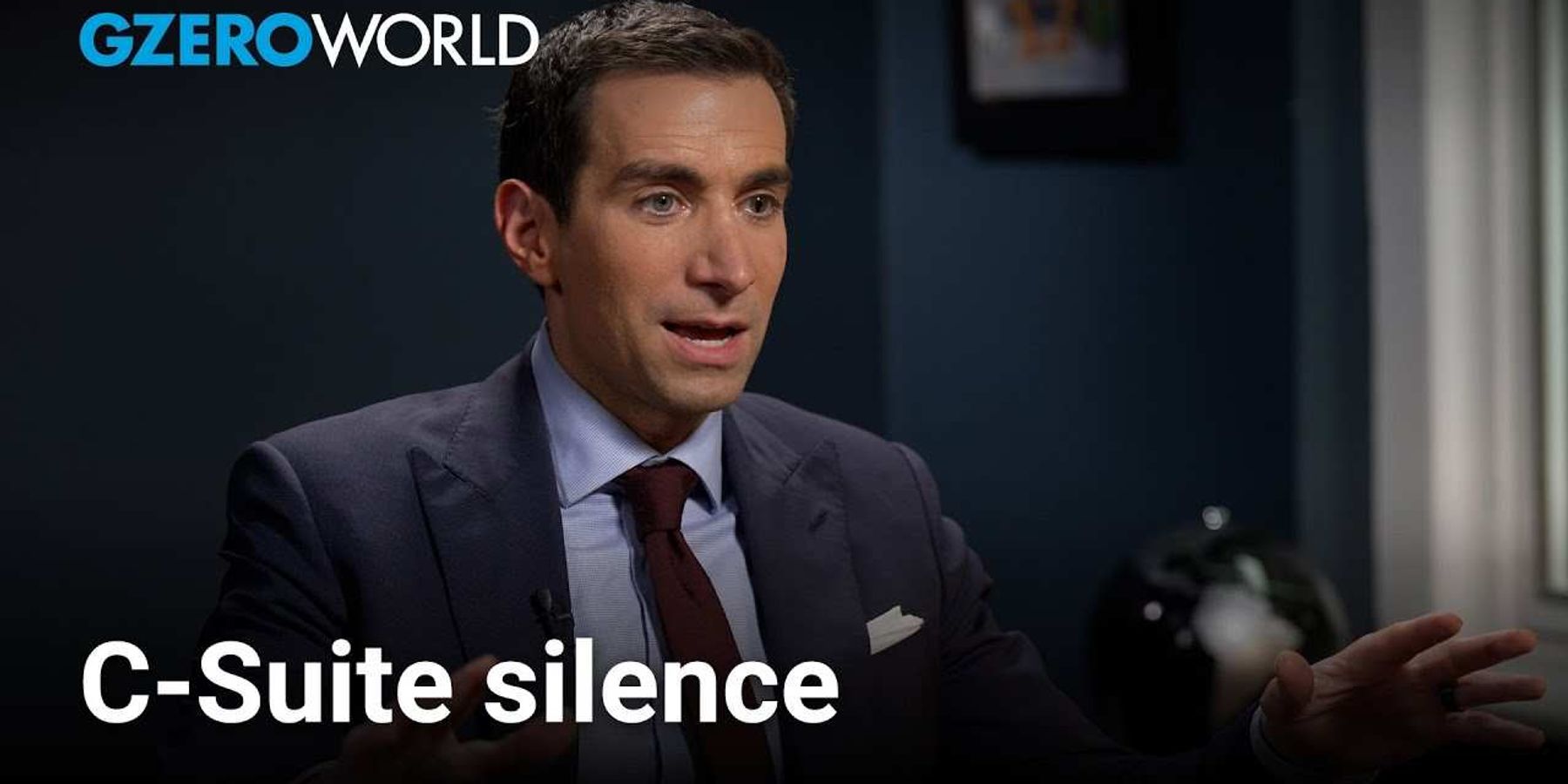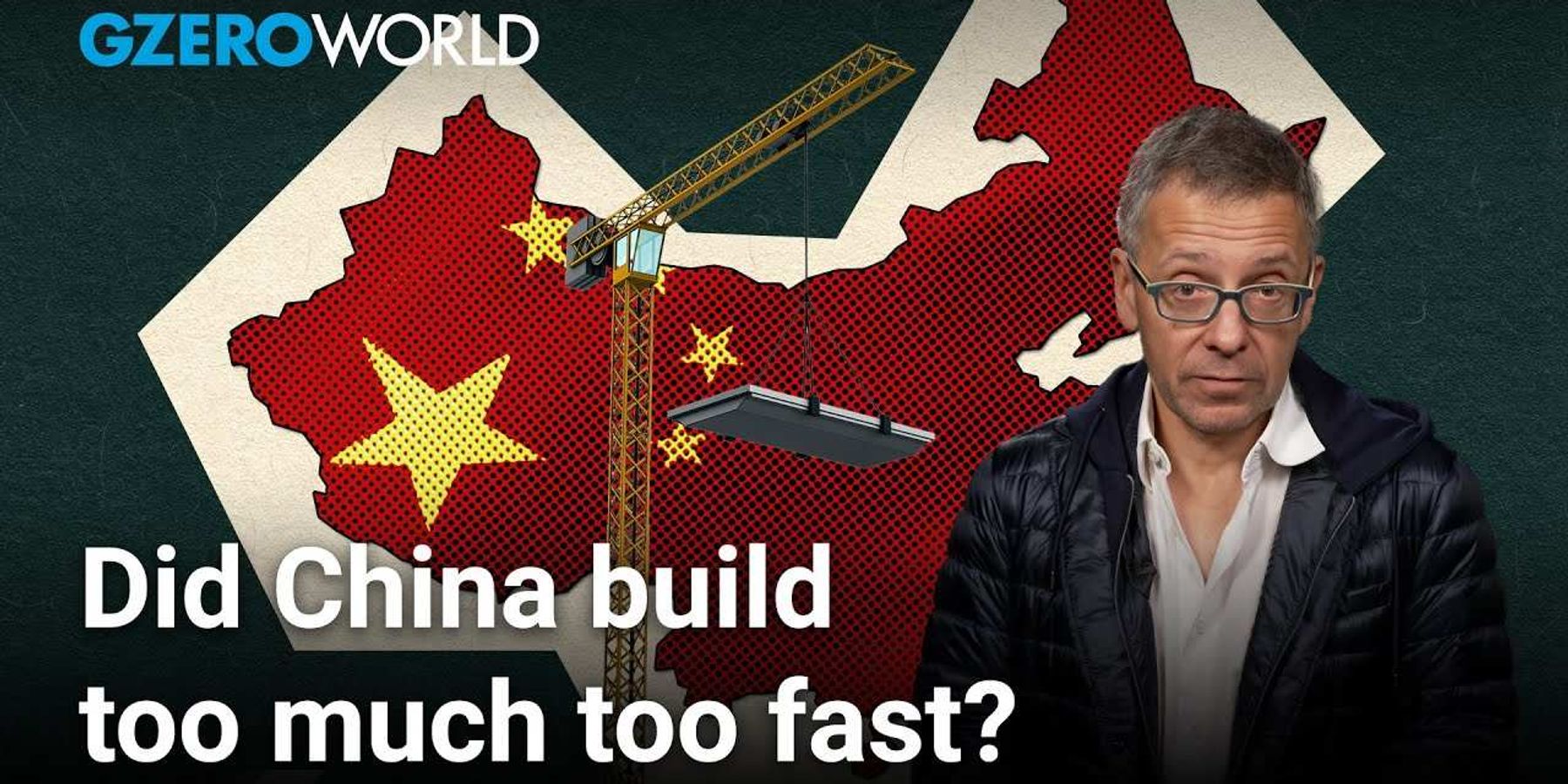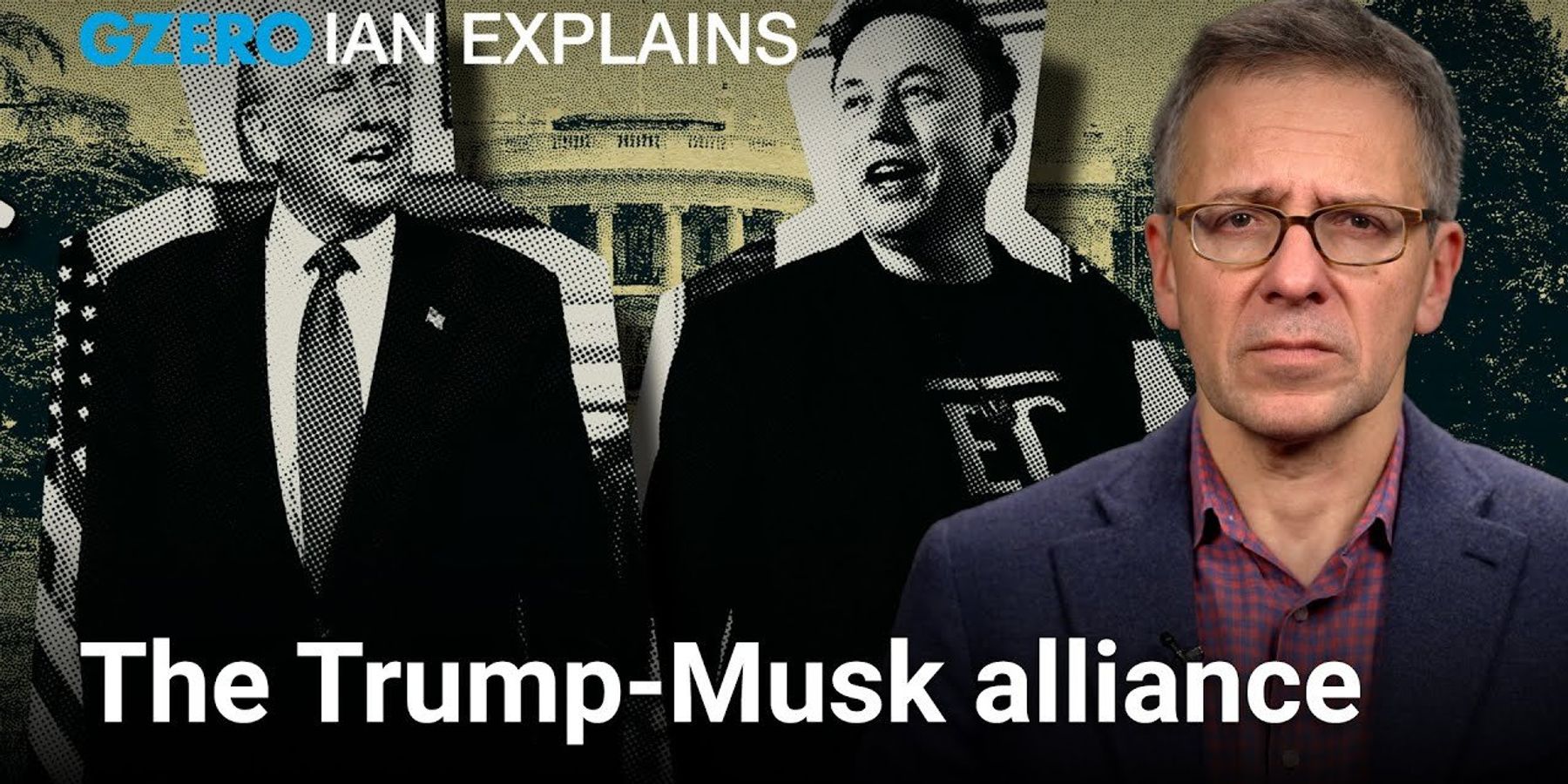Trending Now
We have updated our Privacy Policy and Terms of Use for Eurasia Group and its affiliates, including GZERO Media, to clarify the types of data we collect, how we collect it, how we use data and with whom we share data. By using our website you consent to our Terms and Conditions and Privacy Policy, including the transfer of your personal data to the United States from your country of residence, and our use of cookies described in our Cookie Policy.
{{ subpage.title }}
Sorkin: A financial crisis is coming and CEOs are scared to speak out
“Most CEOs are really unwilling to say anything,” he tells Ian Bremmer. “They'll talk to you privately, absolutely. But publicly, unless they're going to be in praise of what's ever happening in Washington… they are not willing to raise their hand and say, ‘this is a problem."
Sorkin points to fear—both political and reputational—as a key reason why tech and financial leaders stay silent. “If I raise my hand now, I may not have a hand,” he says. “Should I raise it now? Should I raise it later? And will there be a later?”
As economic uncertainty grows, he questions whether the public can count on the private sector to lead. “If we ever get to a moment where there is a crisis… are there going to be leaders willing to stand up and explain what needs to happen?”
GZERO World with Ian Bremmer, the award-winning weekly global affairs series, airs nationwide on US public television stations (check local listings).
New digital episodes of GZERO World are released every Monday on YouTube. Don't miss an episode: subscribe to GZERO's YouTube channel and turn on notifications (🔔). GZERO World with Ian Bremmer airs on US public television weekly - check local listings.
What the US can learn from China's infrastructure boom
But after the boom, often comes the bust. China’s experience can be both a roadmap and a warning. The results of its building spree have been astounding: more high-speed rail than the rest of the world combined, soaring GDP growth, hundreds of millions lifted into the middle class. But the People’s Republic is now dealing with a stagnating economy. Local governments that financed all that construction are drowning in debt. China bet on physical infrastructure. The US is gambling on digital. If AI doesn’t deliver on its promise, both could end up in the same place: buried under the weight of their own ambition.
GZERO World with Ian Bremmer, the award-winning weekly global affairs series, airs nationwide on US public television stations (check local listings).
New digital episodes of GZERO World are released every Monday on YouTube. Don't miss an episode: subscribe to GZERO's YouTube channel and turn on notifications (🔔). GZERO World with Ian Bremmer airs on US public television weekly - check local listings.
U.S. President Donald Trump and Canada's Prime Minister Mark Carney talk during a family photo at the G7 Summit in Kananaskis, Alberta, Canada, June 16, 2025.
What We’re Watching: Trump and Carney to discuss Canada tariffs, Macron under pressure to resign
Carney heads to Washington, seeking tariff relief from Trump
Canadian Prime Minister Mark Carney will meet President Donald Trump at the White House on Tuesday seeking relief from US tariffs that have hit key exports. It comes after Trump threatened to impose an additional 25% tariff on trucks entering the country on Monday, a move that would significantly disrupt the auto industry's supply chains. Trump has already imposed a 35% tariff on Canadian goods, citing disputed claims about migration and fentanyl. Hopes for progress today are low, but as next year’s North American trade deal review is looming, Carney aims to preserve ties with the US president while strengthening them with Mexico to increase Canada’s leverage.
France’s Macron under pressure to step down
L’etat, c’est.. en émoi? France is in political turmoil as pressure grows on President Emmanuel Macron to resign or call snap elections. Yesterday, France’s fifth Prime Minister in two years resigned just hours after forming his cabinet. Europe’s second largest economy has been deadlocked since a 2024 snap election resulted in a hung parliament. The centrist Macron has long been under pressure from the surging far right National Rally, as well as from a left wing coalition that effectively prevented the far right from winning even bigger in 2024. But now mainstream allies are breaking with him too. Will Macron make it to the end of his term in 2027?
Is the US Intelligence community at a breaking point?
With Congress slowing down during the summer recess and President Trump fresh off some major victories—from a joint US-Israeli strikes on Iran’s nuclear infrastructure to pushing through a massive tax and spending bill—Ian Bremmer heads to Capitol Hill to hear how Democrats are responding on the latest episode of GZERO World. Senator Mark Warner, who chairs the Senate Intelligence Committee, is sounding the alarm about a deeper crisis: an intelligence system being weaponized for politics. “Analysts are being told to change their conclusions—or lose their jobs,” he says. “We’re in uncharted, dangerous territory.”
Finally, Warner spotlights a crisis few in Washington are talking about: Sudan. “More people die there every day than in Gaza and Ukraine combined,” he says. If Trump leverages his ties to the Saudis and UAE to stop funding the war, Warner believes it could be a rare and meaningful win.
GZERO World with Ian Bremmer, the award-winning weekly global affairs series, airs nationwide on US public television stations (check local listings).
New digital episodes of GZERO World are released every Monday on YouTube. Don't miss an episode: subscribe to GZERO's YouTube channel and turn on notifications (🔔).
U.S. President Donald Trump welcomes Israeli Prime Minister Benjamin Netanyahu at the entrance of the White House in Washington, D.C., U.S., April 7, 2025.
What We’re Watching: Bibi heads to Washington, Deadly Texas floods get political, Kenyan police shoot protesters
Bibi’s back in Washington
Israeli Prime Minister Benjamin Netanyahu meets US President Donald Trump at the White House this evening, their third encounter there this year. Trump is pressing for a ceasefire in Gaza, after claiming Friday that a 60-day deal could be reached, in which Hamas would return 10 living and 18 dead hostages, Israeli forces would withdraw to a buffer zone along Gaza’s borders with Israel and Egypt, and aid would be distributed again by UN agencies and the Palestinian Red Crescent. As of this writing, however, indirect talks between Israel and Hamas were still ongoing.
Killer floods sweep through Texas
Even as rescuers are still searching for survivors of the Texas floods that have so far killed more than 80 people, including many children, the political finger pointing has begun. Homeland Security Kristi Noem blamed outdated National Weather Service systems, while critics say federal workforce cuts – including to weather forecasting agencies – have weakened disaster preparedness and left communities more vulnerable to catastrophic weather events.
Kenya’s police open fire on anti-government protesters
Police are cracking down on mass protests marking the 35th anniversary of Kenya’s return to democracy. Demonstrators and rioters – angry about cost of living, corruption, and police brutality – are calling for the resignation of President William Ruto, who won the 2022 election. Ruto’s alliance with the main opposition group has so far been a bulwark against anger from the streets – could that change? The next election is set for 2027.Will the Trump-Musk relationship last?
How long will President Donald Trump’s relationship with Elon Musk last? The alliance has so far defied predictions from the left (and parts of the right) that a relationship between two famously impulsive and mercurial billionaires would eventually lead to conflict. Instead, Musk is everywhere in the Trump administration—attending cabinet meetings, shaking hands with world leaders, smiling in the Oval Office. Musk’s Department of Government Efficiency, or DOGE, has embedded itself across nearly every federal agency. In many ways, the relationship is mutually beneficial: Musk has an almost limitless checkbook to bankroll Trump’s political operations, and DOGE is helping him deliver on a campaign pledge to “shatter” the deep state. Meanwhile, Musk has become the most powerful person in Washington, not named Trump. But the president also has a history of discarding allies when they are no longer valuable and many of his close advisors have become his harshest critics. So, can the Trump-Musk alliance survive for the long haul, or is it destined to go up in flames?
Watch the upcoming episode of GZERO World with Ian Bremmer on US public television this weekend (check local listings) and at gzeromedia.com/gzeroworld.
Trump through the looking glass
The shocking US pivot to Russia has sent the world through the political looking glass and into the upside-down era of Trumpland. Is the US abandoning its historic allies in NATO, Europe, and Canada in favor of … Russia?
The short answer is yes. For now.
Let’s start with exhibit A: the inversion of facts to justify the abandonment of Ukraine.
President Donald Trump has, to steal a Lewis Carroll phrase by the QAnon movement, followed the white rabbit down the disinformation hole. According to him, Ukraine started the war, not Russia. “You should’ve never started it,” Trump said this week about Ukrainian President Volodymyr Zelensky. “You could’ve made a deal.”
Wait, what?
Didn’t the war start when Vladimir Putin invaded Crimea in 2014? Didn’t it escalate when he invaded the country — three years ago this Saturday — in February 2022, bombing cities and trying to assassinate Zelensky?
Those are the facts that NATO nations have long accepted … because they are true. Putin was the dictator who started the war, and Zelensky the defender of democracy.
Not for Trump.
He now calls Zelensky “a Dictator without Elections,” not Putin. Parroting Russian propaganda, Trump claims that Zelensky has only 4% support in his country and so has no standing to be part of the peace negotiations.
“Curiouser and curiouser,” as Alice said, gazing around the new world of Wonderland. This just doesn’t make much sense.
Once you go through the political looking glass, the flow of disinformation threatens to overwhelm reality. Fact-checking is suddenly seen as a radical form of partisanship, but it shouldn’t be. Facts are facts. The truth is, in the last presidential election, Zelensky won 73% of the vote. It is also true that, since then, the war and martial law in Ukraine delayed the elections that were scheduled for last May, and concerns about that are legitimate. But as the UK prime minister pointed out, during World War II, Britain also suspended elections.
Zelensky responded in fury, saying that Trump “lives in this disinformation space.”
Europe is reeling at the pivot — suddenly aware that their closest ally and friend has shifted toward Russia. European leaders, who have been holding a series of emergency meetings, are now realizing that if they want to defend themselves from Russia, they have to do it themselves. It’s not so much a wake-up call as a lifesaving shock from a political defibrillator. But it will be expensive and fraught with internal obstacles.
The sense of betrayal in the EU is overwhelming. Kaja Kallas, vice president of the European Commission, described this as “appeasement,” while Friedrich Merz, the man most likely to lead Germany after Sunday’s election, called it “a classic reversal of the role of perpetrator and victim.”
Even former British Prime Minster Boris Johnson, who supports the idea of helping Trump end the war, couldn’t defend the absurdity of Trump’s view. “Of course Ukraine didn’t start the war. You might as well say that America attacked Japan at Pearl Harbor,” he wrote.
The truth is that European leaders are in full panic, watching the postwar multilateral world they worked so hard to build on the foundation of US support collapse.
Meanwhile, the Russians aren’t just throwing a Lewis Carroll-like tea party but a Kremlin-sponsored vodka chug-a-thon. The Russians have long courted far-right MAGA types like Tucker Carlson through their common interest in fighting “woke” culture and promoting Christian nationalism — all while maintaining their focus on weakening NATO and breaking up the alliance. Even they can’t believe their success.
“If you’d told me just three months ago that these were the words of the US president, I would have laughed out loud,” Dmitry Medvedev, the former Russian president wrote, not bothering to hide his gloating. “Trump is 200 percent right.”
“He is the first, and so far, in my opinion, the only Western leader who has publicly and loudly said that one of the root causes of the Ukrainian situation was the impudent line of the previous administration to draw Ukraine into NATO,” said Russian Foreign Minister Sergei Lavrov, cementing Russian propaganda as a Trumpian truth.
As I argued last week, this is part of Trump’s empire state of mind, his neo-imperialist goal of dividing the world into spheres of influence controlled by strongman leaders in countries like Russia and China. China is seeing all this through the lens of invading Taiwan, something that must look far more palatable to the current US administration as it retreats from its role as a global police officer and looks increasingly likely to join the mob looting weaker sovereign territories. Small countries who get in the way — Ukraine in this case, the Panamanians in another, and maybe Taiwan — have little or no say in the outcomes.
Other countries that have been threatened by Trump, like Canada, are watching nervously. After all, the propaganda Putin uses to talk about Ukraine — there is an artificial border where one never should have existed, that Ukrainians actually want Russia to come and protect them — sounds eerily familiar to the language Trump has used about Canada. He has called the US-Canada border an “artificially drawn line” and claimed, without proof, that most Canadians would welcome the US taking over the country to offer protection.
Earlier today, just hours before the 4 Nations hockey final between the US and Canada, Trump made it political. The event has been supercharged by the political climate to the point where Canadian fans booed the US national anthem during a round-robin matchup last weekend in Montreal. Expect the Canadian anthem to receive a similar treatment tonight in Boston. “I’ll be calling our GREAT American Hockey Team this morning to spur them on towards victory tonight against Canada, which with FAR LOWER TAXES AND MUCH STRONGER SECURITY, will someday, maybe soon, become our cherished, and very important, Fifty First State,” Trump posted.
The threats are by now familiar, but the pivot toward Russia adds a more concerning element. Once he went through the looking glass and accepted the lie that Ukraine started the war, Trump implicitly accepted the idea that a manufactured threat can be a justifiable pretext for the most radical action.
Trump 1.0 already used the pretext of national security to slap tariffs on Canadian steel and aluminum, and his Trump 2.0 tariff wars and threats are no different. What happens when Canada responds in kind with reciprocal tariffs designed to hurt the US economically? Will it be long before Canada is accused of starting the tariff war? Does that quickly evolve into a pretext for more drastic US action to make Canada the 51st state? After all, it is just … self-defense.
All this sounds like phantasmagorical, political hyperventilating, and frankly paranoid. The rhetoric about the US taking over Canada the way Russia invaded Ukraine must be a joke, a trick to gain the upper hand in good old-fashioned trade negotiations. Right? Right?
Let’s hope.
But then, Trump has a Napoleonic view of his powers and the rule of law. “He who saves his Country does not violate any Law,” he posted on social media last weekend. If he does not see himself bound by US constitutional law, why would he feel bound by international law?
This US pivot toward Russia marks the most dangerous threat to the multilateral world’s adherence to the rule of law and the NATO alliance in general. It is not a bug of the Trump presidency; it is a feature. Everything has changed. “I can’t go back to yesterday because I was a different person then,” Alice says as she absorbs what has happened to her.
The Western world can’t go back either. There is malice in Wonderland now, and it is no longer just Russia; it’s the United States itself.
Ukraine's President Volodymyr Zelenskiy gives a press conference in Kyiv, Ukraine, on Feb. 19, 2025.
Trump feuds with Zelensky, cozies up to Putin
The war of words between US President Donald Trump and Ukrainian President Volodymyr Zelensky hit a new nadir on Wednesday after Trump labeled Zelensky a “dictator” who “has done a terrible job.” Trump criticized Zelensky for imposing martial law and suspending elections, ignoring the fact that both actions were taken because of Russia’s invasion and ongoing war.
Reaction has been swift. Both British Prime Minister Keir Starmer and German Chancellor Olaf Scholz condemned Trump’s remarks and expressed support for Zelensky’s legitimacy. In contrast, Russia’s ambassador to the UK, Andrei Kelin, praised the Trump administration for having “an understanding of what (Russia) is doing, why we are doing it, and what should be the outcome of it … For the first time we have noticed that [the US] are not simply saying that this is Russian propaganda and disinformation.”
Why does MAGA support Moscow? Anti-Ukraine sentiment dates back to a false MAGA narrative that blamed Ukraine, not Russia, for interference in the 2016 election. Putin also finds favor with Trump supporters for being “completely clear and completely correct on the society-destroying nature of wokeness and postliberal leftism,” in the words of right-wing writer Rod Dreher.
What’s next for Ukraine? The US and Russia agreed in Riyadh to designate teams to negotiate the end of the war and to reestablish diplomatic channels. French President Emmanuel Macron and Starmer will meet with Trump in Washington, DC, next week, while Zelensky is meeting with Washington's Ukraine envoy, Keith Kellogg, this Thursday. Time is of the essence: On Truth Social, Trump threatened that “Zelensky better move fast or he is not going to have a country left.”


